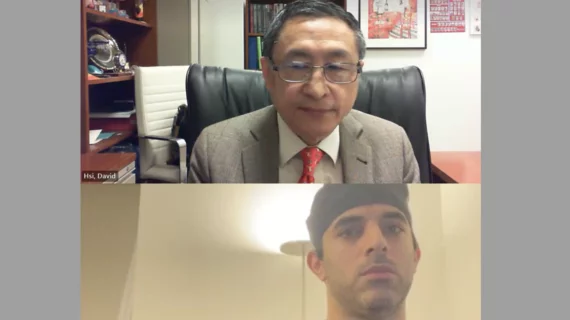Q&A: Cardiologists explore the potential impact of a screening program for aortic stenosis
Aortic stenosis (AS) is quite common among older patients, and severe AS can be fatal if left untreated with transcatheter aortic valve replacement (TAVR), surgery or other medical therapies. However, no guidelines currently exist regarding the screening of asymptomatic patients for AS. Does this represent a missed opportunity to identify more patients with AS early who may benefit from TAVR, surgery or other treatments?
A team of cardiologists recently examined this topic in Trends in Cardiovascular Medicine, proposing an AS screening program based on transthoracic echocardiograms (TTEs).[1]
Under the proposal, all patients over the age of 75 would be screened for AS. Patients 70 years old or older with dialysis dependent end-stage renal disease (ESRD) would also be included, because ESRD is associated with a risk of developing AS earlier in life.
To learn more about the group’s proposal, Cardiovascular Business spoke with corresponding author David Hsi, MD, chief of cardiology at the Heart and Vascular Institute at Stamford Hospital, and co-author Arzhang Fallahi, MD, an interventional cardiologist with the Heart and Vascular Institute.
Read the full conversation below:
Cardiovascular Business: What made you first consider the idea of an AS screening program?
Arzhang Fallahi, MD: A few years ago, some patients were referred to our program when their AS was already critical. Dr. Hsi and I started wondering why AS couldn’t be caught earlier, and that sparked a whole conversation about how there are no official recommendations for screening AS unless a doctor specifically detects a murmur during a physical exam.
We do colonoscopy screening, and that’s a very invasive and expensive screening tool, but we don’t have any guidelines for screening for valvular heart disease. Why is that? So we started discussing it more and more and looking at the literature.
How did you decide on the details for your proposed AS screening program? What were those discussions like?
Arzhang Fallahi, MD: We learned that screening the general population—young patients, old patients—would have a negative result and be tremendously expensive. But if you target the screening toward a high-risk demographic—we’re talking about those patients who are 70 to 75 years and above—we propose that there would be a real benefit in terms of early detection.
One of our goals with this paper was to simplify the screening process. There’s a lot of literature that measures how good doctors are at listening to patients’ hearts—and actually, we’re not very good. I think the reality of medicine is, people don’t take enough time to listen to their patients—they always have to listen to the stethoscope. Our question was, can we have a cutoff for our screening program that is based on age? Most other guidelines are based on age or a genetic predisposition, so we wanted to do the same thing and really simplify things.
Under your proposed screening program for AS, what are the next steps after the initial screening?
David Hsi, MD: For patients without evidence of AS, our current proposal is to do the one-time screening and nothing further. However, patients with any evidence of AS would need to be seen at regular intervals for a follow-up depending on the AS severity. For severe patients, you would follow the clinical guidelines and see them after six to 12 months for an echocardiogram. For minor to moderate AS, the interval would be longer.
Why is it so important to identify AS early in asymptomatic patients?
Arzhang Fallahi, MD: First, I think we have to be very careful about the term “asymptomatic.” There is evidence that about one-third of patients who claim to be asymptomatic actually do show symptoms of AS. But as far as early detection goes, it’s so important because you want to be able to help a patient before they start experiencing irreversible damage to their heart and before their ejection fraction drops. That’s really what spurred us to start this paper to begin with—we kept seeing cases where the disease was identified very late, and the patients were crashing in the ICU.
We want to get to these patients when it’s safer to treat them; we don’t want the very first symptom to be heart failure or even sudden death. And about 1-3% of patients with severe AS present with sudden death.
David Hsi, MD: Patients with untreated severe AS have a higher risk of mortality than most common cancer patients. This is a very serious issue with a poor prognosis, and current treatment guidelines even approve interventions for so-called asymptomatic patients with severe AS because of that high risk of sudden cardiac death and other complications.
What can you tell me about the potential costs of AS screening?
David Hsi, MD: We spent a lot of time researching the costs, though we primarily focused on cash payments—all of the different insurance company reimbursement rates became impossible to compare. With that said, AS screening using TTEs was cheaper than screening for colorectal cancer with colonoscopies. And AS screening is more expensive than a CT screening for lung cancer or a screening mammogram for breast cancer, but those patients will all likely be screened multiple times. We are proposing a one-time screening for AS.
Also, we feel that the costs associated with AS screening can be substantially decreased if handheld devices are used, which is becoming more common. Handheld devices are used by medical residents, primary care physicians, everyone. They could easily be incorporated into an AS screening program. Artificial intelligence could even be used in the future for AS screening. It’s too early right now, but that is an interesting direction it could go in the future.
Read the team’s full proposal here.

